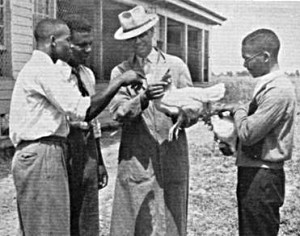Sustainable Agricultural Food Resources

circa early 1940s
University of Maryland Eastern Shore students and faculty have benefited from farm animals housed on campus dating back to its founding in the late 19th century.
As an 1890 land-grant institution, agriculture instruction played a central role in the lives of many who came to study and teach in Princess Anne. That mission evolved with the changing times, but livestock retains a cornerstone presence on the university’s 745 acres.
A sampling of facts about campus animals:
- At the 1913 graduation, a graduate-led ‘Industrial Exhibit’ featured demonstrations such as separating milk, churning butter, hatching chickens and cooking.
- Principal Thomas H. Kiah saw a need to acquire a tractor in 1917 to reduce the number of draft animals needed – so it seems they were used then for labor.
- By 1917, extension agents were helping students learn about raising poultry, hogs and dairy production by utilizing a small herd of Guernsey cows. There was also a thoroughbred bull.
- By the mid-1920s, the campus farm and gardens were producing vegetables, dairy products and meat supplies as needed and consumed.
- A cattle herd was used in the 1950s primarily for the production of milk, which was processed in Trigg Hall for the campus dining hall. Butter and ice cream also were made from the milk, and consumed by teachers and students alike.
- Eggs from chickens also provided food for campus residents, which included faculty members. Trigg Hall’s basement had two processing rooms; one for vegetables and canning and another for milk, cheese and ice cream.
- Milk processing was discontinued in the 1960s and the raw product was shipped to an off-campus milk production company.
- In the ‘50s and ‘60s, agriculture students learned to slaughter (Angus) beef cattle for food. A small herd of pigs also was used for classroom instruction.
- Into the 1960s, the school maintained a flock of range-fed, broiler chickens much the way organic chicken are raised in the 21st century. As the decade drew to a close, the school moved its chickens to broiler housing. Eggs were used for teaching purposes and sent to a company for processing.
- In the late 1980s, the university started producing commercial broiler chickens in a 10,000-bird house. The decision led to the purchase of the HAWK Farm in the 1990s, where approximately 80,000 broilers in four renovated houses were grown annually. The houses eventually became obsolete and were taken out of service.
- By the mid-1980s, a renovated dairy barn with modern milking equipment accommodated a 60-head herd of Holstein cattle. The school supported that dairy operation until the early 1990s, shipping out the milk. When milk farming started to decline, the school sold its dairy cattle.

- Sheep and goats were brought in to replace the dairy herd. They are less expensive to keep on the grounds and are used for research purposes only.
- In the late ‘80s into the early ‘90s, swine confinement buildings were constructed for farrowing and market grow-out. The buildings were equipped with the latest technology, including artificial insemination.
- In the mid-80s to mid-90s, UMES started an on-campus aquaculture initiative. The community-wide project included raising tilapia in 1987, crayfish in 1988 and yellow perch in 1989. This cutting-edge technology in fisheries attracted international dignitaries who were visiting the World Bank in nearby Washington, D.C. The aquaculture project was phased out in the mid ‘90s.
- Horses were boarded on campus briefly at the beginning of the 21stcentury as part of a rescue program from the Midwest, but they did not stay long due to liability issues.
- UMES’ Small Ruminant Farm currently is home to some 70 sheep and 100 goats, which are used for teaching, extension demonstrations and research into synchronized breeding, integrated internal parasite management and forage/pasture utilization.
- Poultry production also has grown into a major research and education program. The focus is on nutritional and environmental research to improve production as well as reduce ammonia emissions. UMES researchers are working to insure Delmarva’s broiler industry will survive and prosper.
The university has a long history of raising and caring for farm animals, which have helped feed generations of students and teachers. The livestock also has helped teach needed skills to agriculture students. Today, the animals make research relevant to the world around us.
Contributors: Dr. George Shorter, Dr. Enrique Nelson Escobar, Dr. Eric May, Dr. Jeannine Harter-Dennis, Bruce Forster and Jennifer Neumyer.

